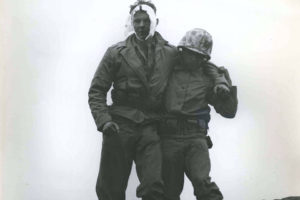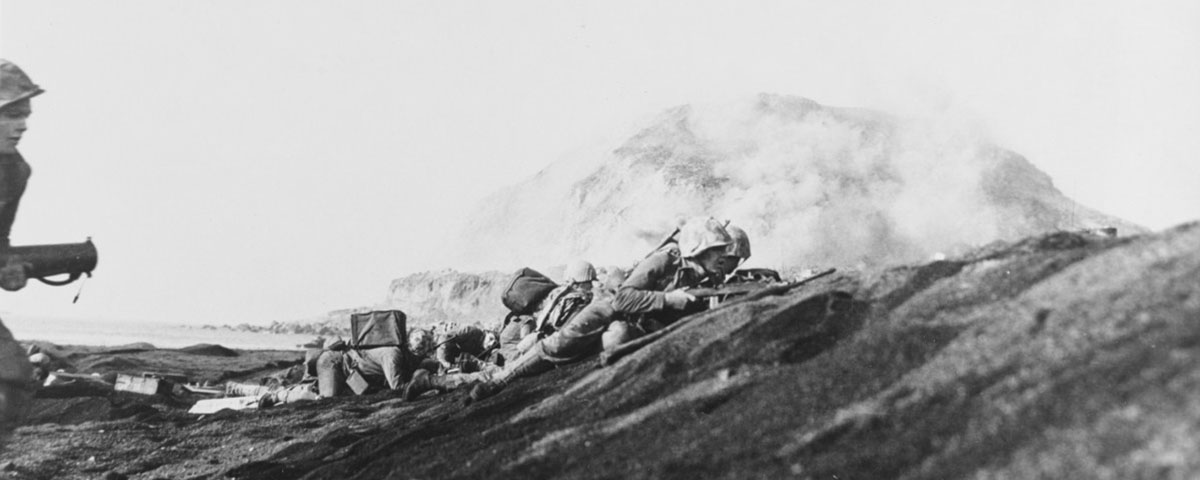The previously anonymous Marine in an iconic Iwo Jima photo shares his story of the battle for the first time.

I first saw the photo (left) when I was in a hospital in Guam in 1945 after being wounded following the initial landing on Iwo Jima. My mother had seen the picture in a New York newspaper and was convinced I was the guy who was all bandaged up, so she mailed the clipping to me. I recognized myself but I didn’t think much about it at the time. I was more concerned with getting back to my unit. Recently, I took a much closer look at the photo when it appeared in World War II Magazine’s special issue on Iwo Jima—and it brought that day on the Japanese island vividly back to life.
Books on the battle will inform you that on February 19, 1945—D-day on Iwo—the Japanese held back their deadly fire until after the first assault wave of U.S. Marines had cleared the beach. That is not entirely true— at least in the experience of my unit, Company C of the 27th Marines.
It was just about five minutes after we had landed. We’d labored through that sticky, sinking black sand to the top of the beach, where we lay momentarily prone, peering over the edge of the terrace ahead. I didn’t hear the shell that landed next—but I heard the moan.
I looked over at my friend, Stan Shofner, just two feet away, and found him with his back blown open and his lungs exposed. I grew up in a pretty sheltered small community on Long Island, N.Y., and nothing in my past prepared me for that terrible sight. Stan had been in the unit for only a month or two; he and I shared a tent with two other men, and he had become a good friend. He wanted to return to Louisville to become a professional baseball player and, in our company fast pitch games back at Camp Tarawa, had shown the grace and ability of a budding Joe DiMaggio. I poured my sulfa powder on his wound as well as I could, but I knew he was dying. I had to leave him to the corpsmen as we advanced.
A little to our left, a hero to all young Marines, Gunnery Sgt. John Basilone, was urging his men off the beach and past the sunken cement pillboxes that fronted it. Basilone had been awarded the Medal of Honor for his defense in October 1942 of an approach to Henderson Field on Guadalcanal while he was greatly outnumbered. He had been asked to return home and help sell war bonds, which he did. But he soon tired of the hero’s life, requested to be assigned to another fighting unit and became part of Company C. He had already single-handedly taken out an enemy blockhouse while under heavy fire. Then a mortar shell killed him and four others in his platoon.
Once we were beyond the beach area, the 28th Marines swung left to attack Mount Suribachi, while the 27th headed straight across the island, crossed the end of the southernmost airstrip and turned north to face the enemy in the rocky ridges ahead. At one point during our advance, some shell fragments lightly nicked a fellow in our squad on the foot. He started jumping up and down, yelling: “I’ve got the Purple Heart! I’ve got the Purple Heart!” Our squad leader quickly told him to shut up. I felt like swatting his helmet with my rifle. A good friend had just had his back ripped open, and here this guy was, making a fool of himself.
As we advanced, the shells began finding us again. Fortunately the U.S. Navy’s own heavy shelling of the island three days before our landing had left some good-sized craters in the ground. I dived into one of them, only to have a shell land so close that I was covered with sand. I found my body unexpectedly trembling while my mind remained clear. Only later did we discover that the Japanese had laid out much of the island in grids, allowing their guns and mortars to hit with amazing accuracy. Perhaps, covered in sand as I was, I appeared dead to the man who had aimed at me.
The barrage stopped shortly, but we knew there were hidden enemy ahead. We turned toward an unfamiliar noise from the rear and were relieved to see that one of our tanks had been able to clear the beach and was lumbering toward us.
Just then my squad leader, Pat Egan, dropped into my hole and said: “Rutan, see that tank coming? We need someone to go out in front of it and try to point out machine gun placements in the rocks ahead. Will you do it?” I didn’t find out until I was in the hospital in Guam that other members of the squad had refused. I simply assumed from our constant and disciplined training that all Marines do what they were asked to do. So off I went.
It was a scary feeling, walking in front of that mechanical monster, its guns blazing away. As best I could, I pointed with my rifle to areas in the rocks ahead that seemed to be the source of machine gun fire. That’s all I remember.
I was later told that a piece of a shell had entered my cheek next to my jawbone, knocking me out, then passed through my throat, missing some vital blood vessels and stopping just under the skin in the back of my neck. I don’t remember anyone coming to bandage my head and help me back to the beach. I must have been well-morphined, for I only dimly remember being lifted up to a hospital ship, where the shell fragment was removed. I was sent to the hospital on Guam, sharing a ward with several of my squad, one of whom had his legs amputated.
Only later, while I was stationed in Japan, did I learn through my Silver Star citation that my work with the tank had prevented Japanese machine guns from cross firing on us, allowing our company to advance. Sergeant Egan, who had been wounded that same day, had written me up for the citation. But there were so many men who had done much more than I had. They were never recognized because their NCOs or officers had been killed and there had been no one to report their actions. That has always bothered me.
Something else has haunted me since then. When I was in the hospital, I had written to Stan’s family, expressing my sympathy on his death and letting them know I admired him tremendously. I didn’t know what else to say then, at my young age. Later Stan’s family wrote me back, requesting more details about their son’s death. I never wrote back: I wasn’t able to find the right words.
When I was released from the hospital, I returned to my outfit for occupation duty in Japan and was finally discharged in January 1946. I was glad to be home again with my family and fiancée Marty, to greet returning friends and to begin building a new life. I attended college and seminary and became a minister, first in Alaska and later in Washington, where I still live.
I’m 83 now and “well-retired,” as I like to say. But I have another bit of unfinished business, and it has to do with that photo. I had seen it several times over the years, but never with any names attached. The man at my side is not someone I recognized; I assumed he was a Navy corpsman. Then a friend spotted the photo in a montage that ran during the closing credits of Clint Eastwood’s recent film, Flags of Our Fathers, and went to look for more information on the movie Website. This time the photo appeared with the words “Arthur Reynolds helping Bert Rutan” beneath it. I assume that someone who’d seen the photo recognized us and supplied the names. So for the first time, I learned the name of the man at my side. I now hope to find Arthur Reynolds, or his family, to thank him.
Originally published in the May 2007 issue of World War II Magazine. To subscribe, click here.





